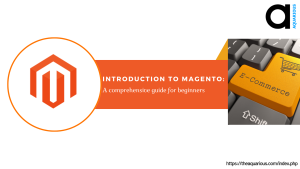Introduction to Magento: A comprehensive guide for beginners

If you wish to set up an online store, look for a solution specially designed for e-commerce.
One of the most influential and well-liked solutions is Magento, which is an excellent place to start. Any dedicated magento developer will tell you that it’s a flexible and enormously expandable option because it’s a free, open-source platform designed especially to handle e-commerce businesses. Additionally, it doesn’t require any additional software to run, making it suitable for almost any kind of e-commerce operation.
Introduction
Magento was created primarily for building online retailers. The platform offers the same user-friendly but configurable design to help you manage your sites, so users accustomed to working with any CMS will still feel at ease with it.

In 2008, Magento was launched as a free, open-source CMS. However, it has subsequently split into two different companies. One of these is the platform’s regular version, which is still free and supported by the community. It is aptly referred to as Magento Open Source.
The Magento Commerce edition, on the other hand, is a premium version with more features that are mainly designed for enterprise enterprises. It has better scalability and gives you access to professional support.
The Architecture Of Magento And Its Key Features
According to a dedicated magento developer, Magento functions very similarly to any other CMS, giving numerous people access to a centralised interface to administer your store. You can change any part of your e-commerce site, including adding products, making categories, configuring functionality and look, and more.
Other significant Magento features entail:
Extensive Search Functions.
One of the essential requirements is the ability to do a product search swiftly. By narrowing down to a product, genre, brand, or SKU level, Magento’s sophisticated and intuitive search tools make it simple for customers to navigate and search for the items they need.
Price And Catalogue Customisation.
It helps dedicated magento developer to give customers a tailored online shopping experience based on their size, industry, geography, order volume, or frequency. Businesses can customise customer experiences and define unique price lists for particular buyer groups with Magento B2B e-commerce.
Simple user Interface.
An ineffective e-commerce purchasing procedure causes organisations to lose a lot of money. An easy-to-use user interface is provided by Magento B2B e-commerce for a seamless buying experience. Customers may place purchases from any device at any moment by using features like quick access to information, easy search, request-for-quote, smart validation, and single-page checkout.
Channel Partners, Key Accounts, and Several Brands.
Any e-commerce platform must be self-sufficient to succeed, whether B2B or B2C. You can provide your customers with a unified brand experience across several brands and regions with Magento B2B e-commerce. Create distinct roles and permissions for each tier of buyers to make it easy for them to manage their accounts and examine thorough order histories.
Quote Request
For most B2B companies today, improving buyer interactions is essential. Businesses can accomplish this by selecting prices and catalogues that cater to the demands of particular customer groups or individuals. Magento’s request for quotation function enhances sales conversion and draws in new customers. Allowing customers to seek quotes enables them to receive the most competitive pricing on goods.
Integrated Inventory Management
Robust inventory management tools are available in Magento B2B e-commerce, which helps to streamline operations and effectively handle orders from various sales channels. Creating a wonderful e-commerce experience and optimising delivery charges and timeframes with real-time inventory data throughout the supply chain is simpler.
Mobile-friendly
80% of B2B consumers utilise mobile devices during the buying process, based on Digital Examiner research. In today’s extremely mobile environment, a seamless, omnichannel e-commerce journey is essential. You can enhance mobile experiences and give your customers the freedom to place orders whenever they want on any device with Magento B2B e-commerce.
How to set up a Magento e-commerce store from scratch
Step 1: Install Magento
Installation of Magento on your website is the first step. Make sure your server can accommodate Magento’s basic requirements and that your hosting package has all the assets the CMS requires before you start. Large stores may experience outages and slowdowns if you don’t use a (VPS) or dedicated hosting package. Hence we strongly advise against it.
- Ensure that PHP has at least 756MB of memory available.
- If you do not have one, set up a MySQL database for your website. Remember that some providers will allow you to build a new database when you install the software.
- Get the Magento version you wish to use by downloading it.
- Transfer the files to the server hosting your website using SFTP. Make care to save them in the root directory of your website.
Step 2: Establish Your Store
The Magento installation wizard will greet you when you attempt to access your site. In this case, you must adhere to the wizard’s instructions, which will assist you in configuring your new store.
- Check for readiness: This verifies that the programme may be installed securely on your website.
- Create a database: For your website, you can create a database here.
- Configuring the web: The basic settings for your store, such as its name and the URL for its administrative portal, are configured here.
- Make your store unique: You can specify information about your store on this screen, including its time zone and default currency.
- Making an admin account You can do this to create your account, which you’ll use to run the shop.
- Install: The final step is setting up Magento on your website.
Your Magento website will be enabled after that is finished.
Step 3: Add Product
Now that you can add material to your website let’s start with the fundamentals.
Go to Catalog > Products to add your first one. You can use a wide variety of different product categories. By doing so, a form allowing you to configure your new product will open. Even though there are so many options that can be overwhelming, the majority are self-explanatory, and many are entirely voluntary or not necessary for the vast majority of items. You can also provide an attribute set on this screen. This is a template that you may use for products that are comparable to it, allowing you to insert all the pertinent details unique to that kind of item. Once you’ve outlined all the required details, click Save to create the item.
Now that you can add material to your website let’s start with the fundamentals.
Step 4: By Using Extensions and Themes, Grow Your Store
Although the default Magento installation is more than capable, you’ll want to add to its existing capacity. To accomplish this, use chunks of code called Magento extensions, which are simple to install on your website. They’ll modify the website’s default features or add new capabilities.
You must utilise the Extension Manager and create an account on the Magento Marketplace to add extensions.
Once you’ve created an account, navigate to System > Web Setup Wizard to activate the Extension Manager.
Selecting Extension Manager from this menu will prompt you to enter your public and private keys. These can be found in the details of your marketplace profile. The Extension Manager will open once you’ve finished.
Wrapping Up
By concentrating solely on e-commerce, Magento differs from other CMS choices. This makes it an adequate substitute if you want to launch an online store because it comes packed with all you would need to build a potent, quick, and secure site out of the box.
Hire a dedicated Magento developer from Aquarious Technology to set up an impeccable online store that runs without hiccups across all platforms.
-
14
+Category
-
98
+Post
Top Categories
Popular Posts
- The Power of Prototyping in Software Development
- Version Control Best Practices for App Development
- Understanding Visual Hierarchy: A Guide to Effective Design
- Crafting Intuitive Navigation: A Guide to Seamless User Experience
- Choose Your Best Cloud Provider
- Making the Leap: Transitioning from Manual to Automated Software Testing
- Using GitHub- Advantages and Disadvantages
- E-commerce Product Photography on a Budget
- Tech Innovation in Developing Countries
- Smart Cities: How Technology is Shaping the Urban Landscape
- Principles of Composition: Creating Visual Harmony with Composition
- Exploring Cross-Platform App Development
- Why Regular Website Updates Matter
- Navigating Effective Facebook Audience Targeting
- Implementing Ads for Game Monetization
- Designing User-Centric Mental Health Apps: Enhancing Well-being in the Digital Age
- NFTs and Collectibles: Creating NFT App Solutions for Collectors and Enthusiasts
- Successful Implementation of Enterprise Apps
- Maximizing Business Impact with EQ
- Proven SMO Ads Optimization Tips (2023)






